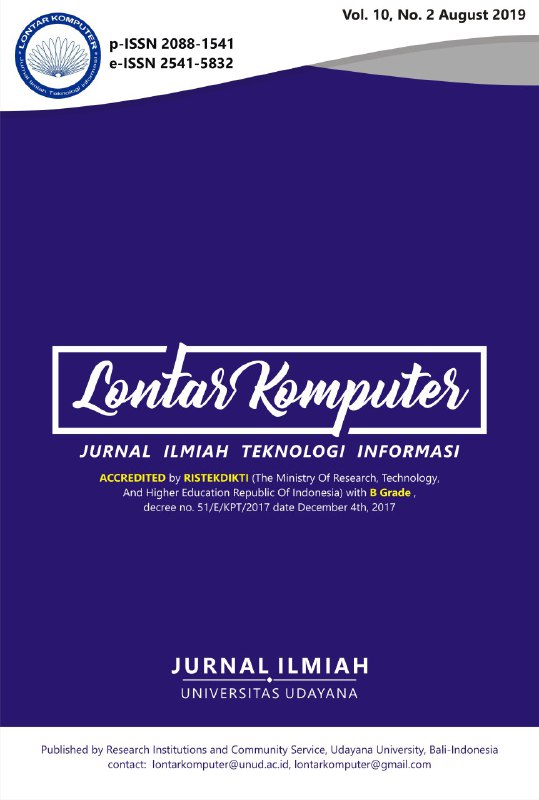Programmer Selection Using Modified Fuzzy Mamdani Method
Abstract
Selection of candidate of the programmer is a complex and tiring process. Software development manager must work hard to guarantee that only qualified candidates will be selected. This study the parameters needed by the programmer are proper and adequate knowledge, skills, attitudes, and productivity. Knowledge, skills, attitudes, and productivity are the four competencies that every programmer must-have. The four components above are very important in developing an IT company. This study proposes a classification model of programmer selection based on certain criteria, parameters, and attributes. This study modifies the Fuzzy Mamdani Method as the approach for determining the feasibility of the programmer. The proposed model has satisfied result of percent of accuracy with 75.57% level. The result indicates that the proposed model has produced a sufficient solution to be used in the real situation for selecting the feasible programmer.
Downloads
References
[2] I. Couso, C. Borgelt, E. Hüllermeier, and R. Kruse, “Fuzzy Sets in Data Analysis : From Statistical Foundations,” IEEE Computational Intelligence Magazine, vol. 14, no.1 February 2019, pp. 31–44, 2019.
[3] F. Bobillo and U. Straccia, “International Journal of Approximate Reasoning Generalizing type-2 fuzzy ontologies and type-2 fuzzy description logics ✩,” International Journal of Approximate Reasoning, vol. 1, pp. 1–27, 2017.
[4] A. Sampson, B. Ransford, and L. Ceze, “A CCEPT : A Programmer-Guided Compiler Framework for Practical Approximate Computing,” vol. 1, no. 14, pp. 1–14, 2015.
[5] S. Vesely, C. A. Klöckner, and M. Dohnal, “Predicting recycling behaviour : Comparison of a linear regression model and a fuzzy logic model,” WASTE Management, vol. 49, March, pp. 530–536, 2016.
[6] B. M. & H. P. Subhashis Chatterjee, “A fuzzy rule-based generation algorithm in interval type-2 fuzzy logic system for fault prediction in the early phase of software development,” Journal of Experimental & Theoritical Artificial Intelligence, vol. 31, issue 3, pp. 369–391, 2018.
[7] N. Cerpa, M. Bardeen, C. A. Astudillo, and J. Verner, “Evaluating different families of prediction methods for estimating software project outcomes,” J. Syst. Softw., vol. 112, pp. 48–64, 2016.
[8] M. Panda, “Developing an Efficient Text Pre-Processing Method with Sparse Generative Naive Bayes for Text Mining,” International Journal Modern Education and Computer Science, vol. 10, no. 9, pp. 11–19, 2018.
[9] A. Benavoli, G. Corani, J. Demsar, and M. Zaffalon, “Time for a change: a tutorial for comparing multiple classifiers through Bayesian analysis,” Journal of Machine Learning Reseach, vol. 18, pp. 1–36, 2016.
[10] A. Fallahpour, E. Udoncy, O. Siti, and N. Musa, “An integrated model for green supplier selection under fuzzy environment : application of data envelopment analysis and genetic programming approach,” Neural Computer and Application, April 2015.
[11] F. Camastra et al., “Expert Systems with Applications A fuzzy decision system for genetically modified plant environmental risk assessment using Mamdani inference,” Expert Systems with Applications, vol. 42, no. 3, pp. 1710-1716, Februari, 2015.
[12] F. Rudziński, “A multi-objective genetic optimization of interpretability-oriented fuzzy rule-based classifiers.,” Applied Soft Computing, vol. 38, pp. 118–133, January, 2016.
[13] P. Ghadimi, A. Dargi, and C. Heavey, “Sustainable supplier performance scoring using audition check-list based fuzzy inference system: a case application in automotive spare part industry,” Computers & Industria Engineering, vol. 105, pp. 12-17, March 2017.
[14] X. Wang, X. Liu, W. Pedrycz, and L. Zhang, “Fuzzy rule based decision trees,” Pattern Recognition, vol. 48, no. 1, pp. 50–59, 2015.
[15] J. A. M. R. Wikström and C. Carlsson, “Mobile Decision Support with Fuzzy Ontology,” Decision Support Systems, vol. 81, pp. 66–75, January 2016.
[16] S. Rajak and S. Vinodh, “Application of fuzzy logic for social sustainability performance evaluation : a case study of an Indian automotive component manufacturing organization,” Journal of Cleaner Production, vol. 108, pp. 1–9, 2015.
[17] K. Grzegorz, A. Gola, and Ś. Antoni, “Application of Fuzzy Logic in Assigning Workers to Production Tasks,” Adv. Intell. Syst. Comput., vol. 13, no. 474, pp. 505–506, 2016.
[18] P. Serrador and J. K. Pinto, “ScienceDirect Does Agile work ? — A quantitative analysis of agile project success,” International Journal of Project Management, vol. 33, no. 5, pp. 1040–1051, July, 2015.
[19] S. Jayanti and S. Hartati, “Sistem Pendukung Keputusan Seleksi Anggota Paduan Suara Dewasa Menggunakan Metode Fuzzy Mamdani,” IJCCS (Indonesian Journal of Computing and Cybernetics Systems, vol. 6, no. 1, 2012.
The Authors submitting a manuscript do so on the understanding that if accepted for publication, the copyright of the article shall be assigned to Jurnal Lontar Komputer as the publisher of the journal. Copyright encompasses exclusive rights to reproduce and deliver the article in all forms and media, as well as translations. The reproduction of any part of this journal (printed or online) will be allowed only with written permission from Jurnal Lontar Komputer. The Editorial Board of Jurnal Lontar Komputer makes every effort to ensure that no wrong or misleading data, opinions, or statements be published in the journal.
 This work is licensed under a Creative Commons Attribution 4.0 International License.
This work is licensed under a Creative Commons Attribution 4.0 International License.























